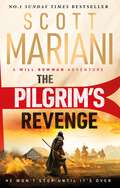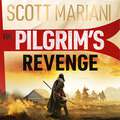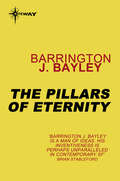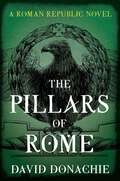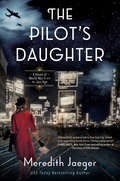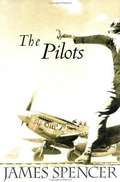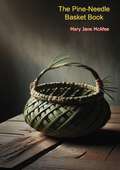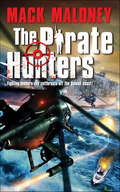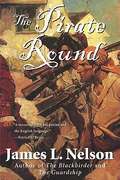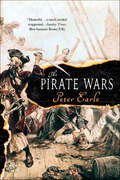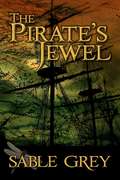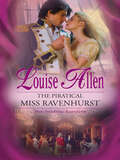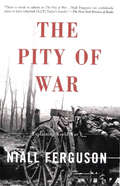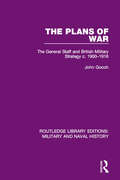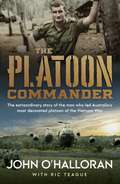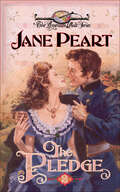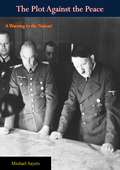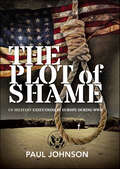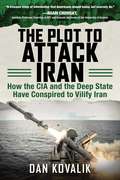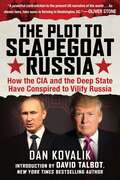- Table View
- List View
The Pilgrim's Revenge: A gripping new 2025 historical revenge adventure epic thriller from the Sunday Times number one bestselling author of the Ben Hope series (Will Bowman Series #1)
by Scott Mariani**Pre-order The Knight's Pledge, the second book in the Will Bowman series, now!**1190 - Humble layman Will Bowman lives in the countryside with his pregnant wife, when soldiers from Richard Lionheart's army tear through his home. Will is beaten unconscious, and awakes to find his wife murdered, his farm burnt down, and his life forever changed. In vengeance, Will infiltrates Richard's army to find the marauding gang, and finds himself swept along in the march of the Crusades. With the help of new allies and fuelled by his loss, Will crosses Europe with the King's army.Can Will avenge his wife? Or will he be swept away by the unstoppable force of Richard's Crusade?
The Pilgrim's Revenge: A gripping new 2025 historical revenge adventure epic thriller from the Sunday Times number one bestselling author of the Ben Hope series (Will Bowman Series #1)
by Scott Mariani**Pre-order The Knight's Pledge, the second book in the Will Bowman series, now!**1190 - Humble layman Will Bowman lives in the countryside with his pregnant wife, when soldiers from Richard Lionheart's army tear through his home. Will is beaten unconscious, and awakes to find his wife murdered, his farm burnt down, and his life forever changed. In vengeance, Will infiltrates Richard's army to find the marauding gang, and finds himself swept along in the march of the Crusades. With the help of new allies and fuelled by his loss, Will crosses Europe with the King's army.Can Will avenge his wife? Or will he be swept away by the unstoppable force of Richard's Crusade?
The Pilgrim's Revenge: A gripping new 2025 historical revenge adventure epic thriller from the Sunday Times number one bestselling author of the Ben Hope series (Will Bowman Series)
by Scott MarianiTHE NEW THRILLER FROM THE NUMBER ONE BESTSELLER1190 - Humble layman Will Bowman lives in the countryside with his pregnant wife, when soldiers from Richard Lionheart's army tear through his home. Will is beaten unconscious, and awakes to find his wife murdered, his farm burnt down, and his life forever changed. In vengeance, Will infiltrates Richard's army to find the marauding gang, and finds himself swept along in the march of the Crusades. With the help of new allies and fuelled by his loss, Will crosses Europe with the King's army.Can Will avenge his wife? Or will he be swept away by the unstoppable force of Richard's Crusade?
The Pillars of Eternity
by Barrington J. BayleyWhen the Colonnaders plucked him from a life of misery and their surgeons rebuilt his twisted body with silicon bones, Joachim Boaz renamed himself after THE PILLARS OF ETERNITY. Now he seeks Meirjaihn the Wanderer, a planet that plots its own course between stars: for on its surface lies a gem that offers mastery over time itself . . .
The Pillars of Rome: A Roman Republic Novel (Republic)
by David DonachieWith barbarians at the gate and enemies within, two men must fight for the soul of the great Roman Republic. History and adventure, brutality and courage combine to powerful effect, making The Pillars of Rome an outstanding opening to the Republic trilogy.In a dark cave lit by flickering torches, two young boys, Aulus and Lucius, appeal to the famed Roman oracle for a glimpse into their future. The Sybil draws a blood-red shape of an eagle with wings outstretched: an omen of death. As the boys flee from the cave in fear, they make an oath of loyalty until death.Thirty years on, Aulus is Rome&’s most successful general and faces his toughest battle. Barbarian rebels have captured his wife and are demanding the withdrawal of Roman legions from their land in return for her life. Meanwhile, Lucius has risen to high rank in the Senate, a position he uses and abuses. But when Lucius is suspected of arranging a murder, the very foundations of the Republic are threatened. Lucius and Aulus soon find themselves on very different sides of the conflict – perhaps the prophecy of the eagle will come true after all.
The Pilot and the Pinup
by Tina HollandFormer pinup model, Sydney Wagner, is about to fulfill her life-long dream of publishing her first novel. Attending a writer's conference in Kansas City is more play than work. Fate factors in, when her car blows a tire on the way to the conference.Pilot and entrepreneur, Peter Kane, notices a car on the side of the road and isn't about to pass up the chance to help a stranded motorist, especially, one as sexy as Sydney Wagner. But can he deal with hot-then-cool attitude, or her tawdry past?
The Pilot's Daughter: A Novel
by Meredith JaegerThe glitzy days of 1920s New York meet the devastation of those left behind in World War II in a new, delectable historical novel from USA Today bestselling author Meredith Jaeger.In the final months of World War II, San Francisco newspaper secretary Ellie Morgan should be planning her wedding and subsequent exit from the newsroom into domestic life. Instead, Ellie, who harbors dreams of having her own column, is using all the skills she's learned as a would-be reporter to try to uncover any scrap of evidence that her missing pilot father is still alive. But when she discovers a stack of love letters from a woman who is not her mother in his possessions, her already fragile world goes into a tailspin, and she vows to find out the truth about the father she loves—and the woman who loved him back.When Ellie arrives on her aunt Iris's doorstep, clutching a stack of letters and uttering a name Iris hasn't heard in decades, Iris is terrified. She's hidden her past as a Ziegfeld Follies showgirl from her family, and her experiences in New York City in the 1920s could reveal much more than the origin of her brother-in-law's alleged affair. Iris's heady days in the spotlight weren't enough to outshine the darker underbelly of Jazz Age New York, and she's spent the past twenty years believing that her actions in those days led to murder.Together the two women embark on a cross-country mission to find the truth in the City That Never Sleeps, a journey that just might shatter everything they thought they knew—not only about the past but about their own futures.Inspired by a true Jazz Age murder cold case that captivated the nation, and the fact that more than 72,000 Americans still remain unaccounted for from World War II, The Pilot's Daughter is a page-turning exploration of the stories we tell ourselves and of how well we can truly know those we love.
The Pilots
by James SpencerIn the dramatic tradition of Philip Caputo and Robert Stone, a remarkable story of men at war. 'Apart from sex, flying was the most exciting thing I'd run across in my twenty years on this planet." James Spencer flew B-24 bombers over New Guinea, Borneo, and the Philippines in 1944 and 1945, and it was only decades later that he began to write about it, combining the literal truth as he remembered it with imagination based on all that he'd seen and heard. The extraordinary result is The Pilots, a novel-in-stories about a group of young men, their comrades and girlfriends, as they evolve in often unpredictable ways: Blake Hurlingame and Steve Larkin, boyhood friends who take different paths into fighters and bombers; Doc, the flight surgeon, battling combat fatigue; Courtenay, the captain whose arrogant bluster masks hidden demons; and Addie, the woman who will leave her mark on them all. These are stories alive with the senses, filled with the smell of hot oil and burnt rubber; the sight of green jungle and backlit clouds like vast sculptured monuments; the feeling of a plane warming up, trembling like a bird eager to be in flight. Several excerpts have already appeared in magazines; now the entire work itself makes a wholly impressive debut.
The Pine-Needle Basket Book
by Mary Jane McAfeeThe Pine-Needle Basket Book by Mary Jane McAfee is a comprehensive guide to creating beautiful and functional baskets from pine needles. The book begins with an introduction to the materials and tools needed for basket weaving, including different types of pine needles, thread, and needles. It then moves on to the techniques of coiling and stitching, with step-by-step instructions and helpful illustrations. The book includes a variety of basket patterns, ranging from simple to complex, with detailed instructions for each. These patterns include traditional designs as well as more modern and creative options. The author also includes tips for customizing designs and adding personal touches to baskets. In addition to basket patterns, The Pine-Needle Basket Book includes information on sourcing materials, preparing pine needles, and caring for finished baskets. The book also features beautiful photographs of finished baskets, showcasing the variety and beauty of this traditional craft. Overall, The Pine-Needle Basket Book is an excellent resource for anyone interested in learning the art of pine-needle basket weaving. Whether you are a beginner or an experienced weaver, this book provides all the information and inspiration needed to create beautiful and unique baskets.-Print ed.
The Pirate Hunters (Pirate Hunters Ser. #1)
by Mack MaloneyThe pirate brandished an AK-47 And his band of desperate thieves and cutthroats is ready to take down a cargo ship containing a fortune in expensive cars . . . and a hundred fortunes in heroin and black market weapons. Zeke Kurjan has done this before, terrorizing the Somali coast, ransoming the crews and contents of ships for millions of dollars. But now they have to contend with Team Whiskey, a hard-bitten cadre of ex-Delta Force vets whose leader, Phil "Snake" Nolan, was given a dishonorable discharge for pursuing Osama bin Laden at Tora Bora. They might not be U.S. warfighters anymore, but Team Whiskey still cares about freedom and protecting the innocent. And they've got the know-how and the weapons to fight these pirate scum. Team Whiskey has the pirates in their sights, but their foes, fueled by greed and revenge, are hellbent on their own deadly mission. Whiskey's in for a hell of a fight on the high seas! At the Publisher's request, this title is being sold without Digital Rights Management Software (DRM) applied.
The Pirate Round: Book Three of the Brethren of the Coast
by James L. NelsonIn 1706, war still rages in Europe, and the tobacco planters of the Virginia colony's tidewater struggle against shrinking markets and pirates lurking off the coast. But American seafarers have found a new source of wealth: the Indian Ocean and ships carrying fabulous treasure to the great Mogul of India. Faced with ruin, former pirate Thomas Marlowe is determined to find a way to the riches of the East. Carrying his crop of tobacco in his privateer, Elizabeth Galley, he secretly plans to continue on to the Indian Ocean to hunt the Mogul's ships. But Marlowe does not know that he is sailing into a triangle of hatred and vengeance -- a rendezvous with two bitter enemies from his past. Ultimately, none will emerge unscathed from the blood and thunder, the treachery and danger, of sailing the Pirate Round.
The Pirate Wars
by Peter EarleInvestigating the fascination pirates hold over the popular imagination, Peter Earle takes the fable of ocean-going Robin Hoods sailing under the "banner of King Death" and contrasts it with the murderous reality of robbery, torture and death and the freedom of a short, violent life on the high seas. The Pirate Wars charts 250 years of piracy, from Cornwall to the Caribbean, from the 16th century to the hanging of the last pirate captain in Boston in 1835. Along the way, we meet characters like Captain Thomas Cocklyn, chosen as commander of his ship "on account of his brutality and ignorance," and Edward Teach, the notorious "Blackbeard," who felt of his crew "that if he did not now and then kill one of them they would forget who he was." Using material from British Admiralty records, this is an account of the Golden Age of pirates and of the men of the legitimate navies of the world charged with the task of finally bringing these cutthroats to justice.
The Pirate's Jewel
by Sable GreyDuring a time when swashbucklers, privateers, and the Royal Navy battled across the waters, one buccaneer stood out from the rest: raven-haired, green-eyed, and nicknamed the Pirate's Jewel. However, this fiery sea rover answers to no one except herself.Captain Merrick Cole has never met a woman as tough and fearless as Rafferty Jones, nor has he ever had one as sexually matched. Clever, cunning, and dangerously sexy, she's just the kind of woman that can stir a man's blood.Following the orders he is commissioned, Cole captures the woman pirate and sets sail back to London where his commander, John Thornton, wants her delivered and hung. But Rafferty Jones proves she will not go easily, nor will she stifle basic human urges along the way. Cole is prepared to entertain her sexual appetites, but can he remain in control when lust turns to love?
The Piratical Miss Ravenhurst (Those Scandalous Ravenhursts)
by Louise AllenA desperate woman disguises herself as a cabin boy on a pirate ship to flee to England in this sexy Regency romance adventure.Alone and in danger, Clemence Ravenhurst is forced to flee her beloved Jamaica, and she falls straight into the clutches of one of the most dangerous pirates in the Caribbean!Nathan Stanier, disgraced undercover naval officer and navigator, protects Clemence on their perilous journey.The heat between them sizzles. But honor—and his guarded heart—dictate that Nathan resist Clemence. Though it seems she’s determined to make their adventure as outrageous—and passionate—as possible!
The Pistol (Phoenix Fiction Ser.)
by James JonesAs Japanese planes attack Pearl Harbor, an army private commits a simple crime that will change his life foreverRichard Mast is a misfit in the infantry unit at Pearl Harbor. A bright mind in a sea of grunts, his only joy on the morning of December 7, 1941, is that today he has guard duty, which means he gets to carry a pistol. Usually reserved only for officers, the close-quarters weapon is coveted by every man in the infantry for its beauty and the sense of strength it gives the wearer. Mast intends to return the gun at the end of his shift—until the Japanese Navy intervenes. Turmoil erupts when the first bombs fall, and as the Army scrambles to organize its response to the swarm of enemy aircraft, Mast decides to hang on to the weapon, becoming a criminal on the day his country most needs heroes. This ebook features an illustrated biography of James Jones including rare photos from the author&’s estate.
The Pity of War: Explaining World War I
by Niall FergusonIn The Pity of War, Niall Ferguson makes a simple and provocative argument: that the human atrocity known as the Great War was entirely England’s fault. Britain, according to Ferguson, entered into war based on naïve assumptions of German aims--and England’s entry into the war transformed a Continental conflict into a world war, which they then badly mishandled, necessitating American involvement. The war was not inevitable, Ferguson argues, but rather the result of the mistaken decisions of individuals who would later claim to have been in the grip of huge impersonal forces. That the war was wicked, horrific, inhuman,is memorialized in part by the poetry of men like Wilfred Owen and Siegfried Sassoon, but also by cold statistics. More British soldiers were killed in the first day of the Battle of the Somme than Americans in the Vietnam War; indeed, the total British fatalities in that single battle--some 420,000--exceeds the entire American fatalities for both World Wars. And yet, as Ferguson writes, while the war itself was a disastrous folly, the great majority of men who fought it did so with enthusiasm. Ferguson vividly brings back to life this terrifying period, not through dry citation of chronological chapter and verse but through a series of brilliant chapters focusing on key ways in which we now view the First World War. For anyone wanting to understand why wars are fought, why men are willing to fight them, and why the world is as it is today, there is no sharper nor more stimulating guide than Niall Ferguson’s The Pity of War.
The Plans of War: The General Staff and British Military Strategy c. 1900-1916 (Routledge Library Editions: Military and Naval History #13)
by John GoochThis book’s contribution to the discussion on the origin’s of the First World War is a pioneering study of both the British General Staff and the evolution of military strategy in the period immediately prior to the war. It describes the development of the General Staff, Britain’s agency for strategic planning, and goes on to give an account of its role in devising strategy. Problems are examined as they arose at grass-roots level in the War Office and progressed upward towards the Cabinet. The complex cross-currents involving the Admiralty, Foreign Office, Treasury and individuals from Edward VII downwards are charted. The account covers British military policy up to 1916, interpreting the Gallipoli campaign and explanation for its failure.
The Platoon Commander
by John O’Halloran Ric TeagueJohn O'Halloran was a country boy from Tamworth, NSW, who was called up for national service not long after the start of the Vietnam War. As a tough and determined 21-year-old, he guided 6 RAR's B Company 5 Platoon through some of the biggest conflicts of the war, including Operation Hobart and the Battle of Long Tan. But he faced his hardest military challenge at Operation Bribie, leading a fixed bayonet charge against a deadly Viet Cong jungle stronghold.The Platoon Commander is an unmissable and devastating first-hand account of the realities and brutalities of war, and especially this war fought in jungles, not trenches, which would go on to bitterly divide Australians. O'Halloran's sense of duty and strong character carried him and his men through fierce battles and uncertainty. His sense of humour kept him going through the years afterwards. His indomitable spirit inspired the men of 5 Platoon to fight against the odds to achieve the mission - no matter how treacherous - and even away from the action and in the many years since O'Halloran kept the respect of his men.Now regarded by many of his peers as a national treasure, John Patrick Joseph O'Halloran has been quoted in almost every important book written about Australia's involvement in the Vietnam War, yet has never told his own remarkable story. Until now.
The Player: The Rebel The Player The Renegade The Rogue (The Moorehouse Legacy #1)
by J. R. WardA powerful man finds the one woman who completes him in this reader favorite, the second book in the Moorehouse Legacy series, from New York Times bestselling author J.R. Ward writing as Jessica Bird, first published as His Comfort and Joy!Ruthless might as well be Gray Bennett’s middle name. When the renowned Washington, D.C., insider talks, powerful people listen. But Gray hasn’t come home to Saranac Lake to play politics. Or play at all. A tragedy has brought Gray Bennett back to face everything he thought he’d left behind.Including the most unlikely of women. The mousy redhead who used to run around the Moorehouse B and B—the one he never noticed—is now all fiery hair and lush curves. But sweet Joy Moorehouse is too innocent for a cynic like him. So Gray won’t let himself lay a hand on her…until the night he can no longer resist the woman she has become. That’s when he discovers a secret that leaves him gasping for breath—and wanting more.Originally published in 2006
The Pledge (The American Quilt Series #2)
by Jane PeartFor the sake of peace in the family, Jo-Beth kept her feelings to herself. But she and Wes were pledged to each other, and nothing could change that. Not even war. With the death of her father, Jo-Beth and her family, moved in with relatives. There, her mother makes a living sewing her exquisite quilts—and Jo-Beth discovers a special friend. Wesley Rutherford draws Jo-Beth like a magnet ... and their attachment to one another becomes strong enough to endure a long separation. Their future together seems certain … until the Civil War forces a decision that places Wes at odds with friends and family. Beginning in the mountains of North Carolina, the American Quilt series takes readers through the Civil War, across the country by wagon train to California, and finally across the Pacific to the romance and wild beauty of Hawaii. At the end of each book, you&’ll find the pattern for its quilt. Follow it to create a beautiful quilt of your own.
The Pledge to America: One Man's Journey from Political Prisoner to U.S. Navy SEAL
by Drago DzieranRetired Navy SEAL Drago Dzieran takes readers behind the scenes of his incredible life, from an impoverished childhood in Communist-controlled Poland to his time as a political prisoner, to his twenty years as a member of the United States military&’s most elite fighting force.Everything I have, I owe to America—the greatest country in the world. I have been fighting oppression and defending freedom my entire life. When I became a United States citizen, I felt it was my moral obligation to give back to this country and the people who had given me freedom. I wanted to serve my new country in the best capacity I could, so when the first Persian Gulf War broke out, I decided to join the military. During my Navy career, I performed over one hundred combat direct action missions in Iraq from 2003 to 2005. My chance to live as a free man is only possible because of the ideals the founding fathers fought for and that have been carried forward to this day by Americans. Every person has a voice, and every voice matters. I will continue to encourage others to get involved, stand up, and preserve and cherish the freedom and liberty we have in America.
The Plot Against the Peace: A Warning to the Nation!
by Michael Sayers Albert E. KahnThe Plot Against the Peace, which was first published in 1945, uncovers Nazi Germany’s secret plans for a Third World War. The book reveals how the behind-the-scenes clique which really rules Germany is plotting to undermine the peace, split the United Nations, and convert military defeat into actual victory.Written by two journalists who have won an international reputation for their exposés of fifth-column activities and worldwide fascist intrigues, this book offers thoroughly documented, indisputable evidence to prove that Germany’s undercover apparatus is at work in the United States today, laying the groundwork for a post-war secret offensive against America. The book disclosed how German spies and assassins are already carrying out their new assignments in the United States, as throughout the rest of the world.The Plot Against the Peace is a book that names names. Among the vitally important disclosures discussed are how Germany is secretly preparing for the continued post-war operations of the Nazi apparatus; the real story behind the German factories of death; the clandestine building of German hidden arsenals in Spain, Argentina and other countries; the plot for maintaining a Nazi-Junker officer corps in temporary exile abroad after the war; who are the “real brains” behind the German international network; how the Germans have smuggled funds, diamonds and other valuables into the United States to finance their post-war machinations; and what the German plans are for disuniting the United Nations, inciting international turmoil and thus making impossible the fulfilment of the Allied peace aims.The authors have left nothing to the imagination in their account of the hitherto untold secret history of Nazism, and in their description of the character and deeds of the German General Staff. But, as the authors write, “Those facts had to be recorded and they have to be read.”An amazing, revealing and urgent document.
The Plot of Shame: US Military Executions in Europe During WWII
by Paul JohnsonThe Oise-Aisne American Cemetery is the last resting place of 6,012 American soldiers who died fighting in a small portion of Northern France during the First World War. The impressive cemetery is divided into four plots marked A to D. However, few visitors are aware that across the road, behind the immaculate façade of the superintendent’s office, unmarked and completely surrounded by impassable shrubbery, is Plot E, a semi-secret fifth plot that contains the bodies of ninety-four American soldiers. These were men who were executed for crimes committed in the European Theater of Operations during and just after the Second World War. Originally, the men whose death sentences were carried out were buried near the sites of their executions in locations as far afield as England, France, Belgium, Germany, Italy, and Algeria. A number of the men were executed in the grounds of Shepton Mallet prison in Somerset – the majority of whom were hanged in the execution block, with two being shot by a firing squad in the prison yard. The executioner at most of the hangings was Thomas William Pierrepoint, assisted mainly by his more-famous nephew Albert Pierrepoint. Then, in 1949, under a veil of secrecy, the ‘plot of shame’, as it has become known, was established in France. The site does not exist on maps of the cemetery and it is not mentioned on the American Battle Monuments Commission’s website. Visits to Plot E are not encouraged. Indeed, public access is difficult because the area is concealed, surrounded by bushes, and is closed to visitors. No US flag is permitted to fly over the plot and the graves themselves have no names, just small, simple stones the size of index cards that are differentiated only by reference numbers. Even underground the dishonored are set apart, with each body being positioned with its back to the main cemetery. In The Plot of Shame, the historian Paul Johnson uncovers the history of Plot E and the terrible stories of wartime crime linked to it.
The Plot to Attack Iran: How the CIA and the Deep State Have Conspired to Vilify Iran
by Dan Kovalik* “Spectacular!” * –Oliver StoneThe world has a lot of questions about the current state of affairs between the United States and Iran… How has the US undermined democracy in Iran? Is Iran really trying to develop nuclear weapons? How has US waged a terror campaign against Iran for years? How is it that the US and Israel, rather than Iran, are destabilizing the Middle East? How has Iran helped the US in the war on terror?In The Plot to Attack Iran, critically acclaimed author Dan Kovalik exposes what Americans have known about the Islamic Republic is largely based on propaganda. The 1953 coup that deposed the democratically-elected prime minister for a US-selected shah? Sold to average American citizens as a necessity to protect democracy and guard against communism. In truth, it was America’s lust for Iranian oil and power that installed the tyrannical shah. The Iranian hostage crisis that miraculously ended with Ronald Reagan’s inauguration as president? Evidence shows that Reagan negotiated with the hostage-takers to hold the hostages until his inauguration.Iran, once known as Persia, is one of the oldest nations on earth. It has a rich history and a unique culture, and is bordered by seven countries, the Caspian Sea, and the Persian Gulf. It is literally the intersection of many countries and many worlds. It has a population of eighty million people and occupies a space nearly the size of Alaska, the largest US state; it is the seventeenth largest country in the world. Over the past century, Iran’s greatest resource, and at the same time its greatest curse, has been its oil. For it is oil that has caused the United States and other world powers to systematically attempt to destroy Iran. After a greedy Iranian monarch sold all of Iran’s oil and natural gas reserves to a British financier in 1901, the West started just one of its many invasions and exploitations of the country.Using recently declassified documents and memos, as well as first-hand experience of the country, critically-acclaimed author Dan Kovalik will change the way you think about Iran, and especially what you think of US interference there. Learn how the United States vilifies its enemies, and accuses them of unspeakable horror to mask its own terrible crimes. Not only does the illuminating and important The Plot to Attack Iran delve into the current incendiary situation, but it also predicts what could happen next, and what needs to be done before it is too late.
The Plot to Scapegoat Russia: How the CIA and the Deep State Have Conspired to Vilify Putin
by David Talbot Dan KovalikAn in-depth look at the decades-long effort to escalate hostilities with Russia and what it portends for the future. Since 1945, the US has justified numerous wars, interventions, and military build-ups based on the pretext of the Russian Red Menace, even after the Soviet Union collapsed at the end of 1991 and Russia stopped being Red. In fact, the two biggest post-war American conflicts, the Korean and Vietnam wars, were not, as has been frequently claimed, about stopping Soviet aggression or even influence, but about maintaining old colonial relationships. Similarly, many lesser interventions and conflicts, such as those in Latin America, were also based upon an alleged Soviet threat, which was greatly overblown or nonexistent. And now the specter of a Russian Menace has been raised again in the wake of Donald Trump’s election. The Plot to Scapegoat Russia examines the recent proliferation of stories, usually sourced from American state actors, blaming and manipulating the threat of Russia, and the long history of which this episode is but the latest chapter. It will show readers two key things: (1) the ways in which the United States has needlessly provoked Russia, especially after the collapse of the USSR, thereby squandering hopes for peace and cooperation; and (2) how Americans have lost out from this missed opportunity, and from decades of conflicts based upon false premises. These revelations, amongst other, make The Plot to Scapegoat Russia one of the timeliest reads of 2017.
